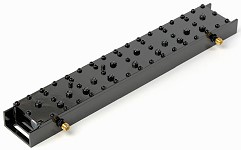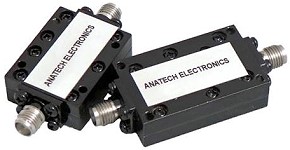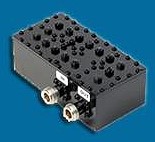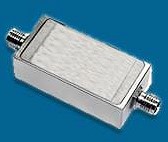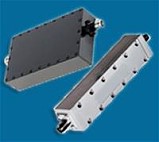Anatech Electronics April 2024 Newsletter |
||

Press Release Archives: 2024 | 2023 | 2022 | 2021 |2020 2019 | 2018 | 2017 | 2016 | 2015 2014 | 2013 | 2012 | 2011 | 2010 2009 | 2008 | 2007 | 2006 | 2005 Content is copyright of company represented. Page format, custom text and images are RF Cafe copyright - do not distribute.
Sam Benzacar, of Anatech Electronics, an RF and microwave filter company, has published his April 2024 newsletter that, along with timely news items, features his short op−ed entitled "Expanding IoT Networks Pose Increased Security Risk," where he reports on the current state of 5G and the Internet of Things (IoT) world. He says there are 20 million IoT devices in service now and an expected 27 million by 2025 (that's next year, believe it or not!). The movement from wired to wireless began with Bluetooth, WiFi, cellular, and even ZigBee to some extent. 5G's stated goal is to have the capability to totally obviate the need for wired interconnections, be it for telephones, computers, security, home appliances, industrial controls, or any other entity needing real-time communications with something else. Of course most equipment requires a separate power supply from batteries (with or without dedicated solar cell array, wind generator, etc.) or the electric power distribution system. Along with the freedom from wires comes subjection to malicious infiltration to collect data and/or to control the device or system. It is an unfortunate fact that there is always someone or some group intent of corrupting and harming others. A Word from Sam Benzacar - Expanding IoT Networks Pose Increased Security Risk
Not too long ago, IoT was merely an acronym, symbolizing the potential of small, connected devices across numerous applications. Like most emerging technologies (with AI being a notable exception), IoT experienced a slow start. One contributing factor was the multiple connectivity options available, ranging from Thread to ZigBee, Bluetooth, Wi-Fi, and, eventually, 5G. It took considerable time for a dominant technology to emerge, but now IoT has become a formidable force, serving hundreds of applications. However, this growth has brought about a significant concern: security. There are at least 20 billion active IoT devices worldwide, with projections indicating an increase to 27 billion connected devices by 2025. Consequently, cybersecurity has become an unavoidable issue as IoT devices typically have limited processing power and memory, leaving them vulnerable to hacking. Once compromised, an IoT device can serve as a gateway for attackers to infiltrate an entire network, potentially accessing sensitive data or disrupting critical systems. The absence of standardization in IoT security protocols and the widespread use of default passwords worsen these risks. IoT devices also rely on firmware rather than dedicated software for their operating systems, and as they are seldom updated, security vulnerabilities in the firmware are easily exploited by attackers.
A 2022 report by the FBI identified many vulnerabilities created by unpatched medical devices running on outdated software and lacking adequate security features. Cyber threat actors can exploit these vulnerabilities to significantly impact healthcare facilities, compromising operational functions, patient safety, data confidentiality, and integrity. Addressing security in IoT networks, starting at the device level, must be prioritized from the design phase through deployment and throughout the device lifecycle, so the future of IoT security rests heavily on the decisions of device manufacturers. If they prioritize security over short-term profits, the overall security posture of IoT ecosystems will improve. However, if manufacturers ignore these issues, hoping nothing "bad" happens, the situation may worsen, leaving users and critical infrastructure vulnerable to an evolving landscape of cyber threats.
The Space Development Agency, which functions within the U.S. Space Force and is dedicated to deploying disruptive space technology, aims to deploy hundreds of small satellites into low Earth orbit to enhance communications and increase data rate as part of the Proliferated Warfighter Space Architecture program. The agency has already launched 27 satellites and plans to launch a second wave later this year and to have 160 when the mission is completed. They are designed to provide global coverage, with more than 24 of the satellites dedicated to missile warning systems and others assigned to missile control operations. FCC Increases What It Considers Broadband to Be
The Biden administration has tasked NASA with creating a new time zone for the moon by the end of 2026. The initiative to create a lunar time zone comes amid growing global interest in establishing a long-term presence on the moon in the coming years, which is a priority of NASA's Artemis program. The new lunar standard, called "Coordinated Lunar Time (LTC)," is part of a broader effort to "establish time standards at and around celestial bodies other than Earth," according to a memo from the White House Office of Science and Technology Policy (OSTP). It was not immediately clear whether the moon would have multiple time zones.
According to Microwave News, an authority on RF radiation effects for more than 40 years, the U.S. National Toxicology Program (NTP), a federal interagency program headquartered at the National Institute of Environmental Health Sciences (NIEHS), has terminated its research program investigating the potential health impacts of RF radiation exposure from wireless communication technologies. This decision effectively ends more than 50 years of research by U.S. civilian agencies into the biological effects of non-ionizing electromagnetic radiation. The NTP's decision to terminate its RF research program comes at a time of rapidly expanding deployment of 5G cellular networks and increasing public concern regarding the potential health ramifications of ubiquitous exposure to millimeter-wave radiation, which had not been comprehensively studied in the NTP's previous toxicology assessments. Anatech Electronics Introduces a New Line of Suspended Stripline and Waveguide Type RF Filters
Check out Our Filter Products
Cavity Band Pass Filters LC Band Pass Filters Cavity Bandstop/Notch Filter About Anatech Electronics Anatech Electronics, Inc. (AEI) specializes in the design and manufacture of standard and custom RF and microwave filters and other passive components and subsystems employed in commercial, industrial, and aerospace and applications. Products are available from an operating frequency range of 10 kHz to 30 GHz and include cavity, ceramic, crystal, LC, and surface acoustic wave (SAW), as well as power combiners/dividers, duplexers and diplexers, directional couplers, terminations, attenuators, circulators, EMI filters, and lightning arrestors. The company's custom products and capabilities are available at www.anatechelectronics.com. Contact: Anatech Electronics, Inc.
Posted April 25, 2024 |
||

 By Sam Benzacar
By Sam Benzacar According to the Nokia Threat Intelligence Report
from June 2023, the number of IoT devices involved in botnet-driven Distributed
Denial of Service (DDoS) attacks has surged from about 200,000 to about 1 million
devices a year. These findings, based on data aggregated from monitoring network
traffic on over 200 million devices worldwide where the Nokia NetGuard Endpoint
Security product is deployed, underscore the severity of the issue.
According to the Nokia Threat Intelligence Report
from June 2023, the number of IoT devices involved in botnet-driven Distributed
Denial of Service (DDoS) attacks has surged from about 200,000 to about 1 million
devices a year. These findings, based on data aggregated from monitoring network
traffic on over 200 million devices worldwide where the Nokia NetGuard Endpoint
Security product is deployed, underscore the severity of the issue.  Space Force to Launch 160 Small Satellites
Space Force to Launch 160 Small Satellites 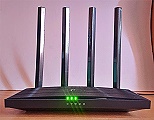 The FCC has raised the bar for acceptable broadband internet speeds, setting
new benchmarks at 100 Mb/s for downloads and 20 MB/s for uploads. This marks a significant
increase from the previous standards of 25 Mb/s down and 3 Mb/s up, which had been
in place since 2015. The decision to redefine these standards has elicited various
reactions from stakeholders in the telecommunications industry, reflecting the diverse
technologies and business models employed by internet service providers (ISPs) across
the U.S. Providers offering fiber-to-the-home (FTTH) services, known for their symmetrical
upload and download speeds, argued against the asymmetrical standard. They suggested
that it could prioritize entertainment over productivity applications, which often
require greater upload bandwidth. On the other hand, the Wireless Internet Service
Providers Association (WISPA), whose members primarily serve rural communities with
fixed wireless access technologies, and Starlink, SpaceX's satellite internet service,
expressed support for the FCC's updated definition of broadband.
The FCC has raised the bar for acceptable broadband internet speeds, setting
new benchmarks at 100 Mb/s for downloads and 20 MB/s for uploads. This marks a significant
increase from the previous standards of 25 Mb/s down and 3 Mb/s up, which had been
in place since 2015. The decision to redefine these standards has elicited various
reactions from stakeholders in the telecommunications industry, reflecting the diverse
technologies and business models employed by internet service providers (ISPs) across
the U.S. Providers offering fiber-to-the-home (FTTH) services, known for their symmetrical
upload and download speeds, argued against the asymmetrical standard. They suggested
that it could prioritize entertainment over productivity applications, which often
require greater upload bandwidth. On the other hand, the Wireless Internet Service
Providers Association (WISPA), whose members primarily serve rural communities with
fixed wireless access technologies, and Starlink, SpaceX's satellite internet service,
expressed support for the FCC's updated definition of broadband.  A Time Zone for the Moon?
A Time Zone for the Moon? 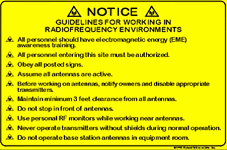 RF Exposure Studies: The U.S. Calls It Quits
RF Exposure Studies: The U.S. Calls It Quits 